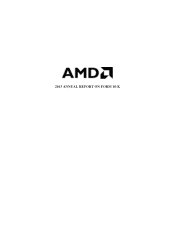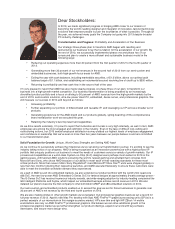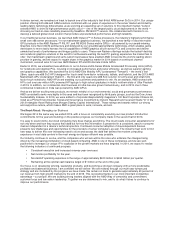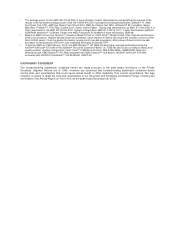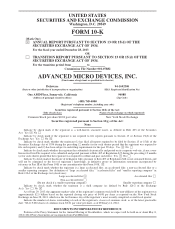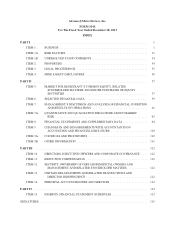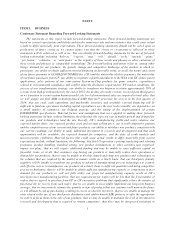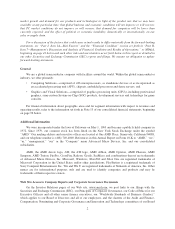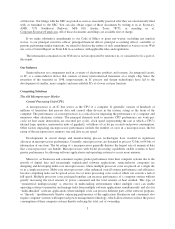AMD 2013 Annual Report Download - page 9
Download and view the complete annual report
Please find page 9 of the 2013 AMD annual report below. You can navigate through the pages in the report by either clicking on the pages listed below, or by using the keyword search tool below to find specific information within the annual report.PART I
ITEM 1. BUSINESS
Cautionary Statement Regarding Forward-Looking Statements
The statements in this report include forward-looking statements. These forward-looking statements are
based on current expectations and beliefs and involve numerous risks and uncertainties that could cause actual
results to differ materially from expectations. These forward-looking statements should not be relied upon as
predictions of future events as we cannot assure you that the events or circumstances reflected in these
statements will be achieved or will occur. You can identify forward-looking statements by the use of forward-
looking terminology including “believes,” “expects,” “may,” “will,” “should,” “seeks,” “intends,” “plans,”
“pro forma,” “estimates,” or “anticipates” or the negative of these words and phrases or other variations of
these words and phrases or comparable terminology. The forward-looking statements relate to, among other
things: demand for our products; the growth, change and competitive landscape of the markets in which we
participate; our ability to obtain sufficient external financing on favorable terms, or at all; the nature and extent
of our future payments to GLOBALFOUNDRIES Inc. (GF) and the materiality of these payments; the materiality
of our future purchases from GF; our ability to negotiate a fourth amendment to the WSA with GF; future patent
applications; sales patterns of our semi-custom System-on-Chip products for game consoles; expenditures
related to environmental compliance and conflict minerals disclosure requirements; PC market conditions; the
success of our transformation strategy; our ability to transform our business to attain approximately 50% of
revenue from high-growth markets by the end of 2015; the decline of royalty revenue received from third parties
as we transition to a semi-custom business model; the level of international sales as compared to total sales; that
we will sample our first ARM technology-based AMD Opteron™processor for servers in the first quarter of
2014; that our cash, cash equivalents and marketable securities and available external financing will be
sufficient to fund our operations including capital expenditures over the next twelve months; our dependence on
a small number of customers; our hedging strategy; and the timing of the implementation of certain
ENERGYSTAR specifications. Material factors and assumptions that were applied in making these forward-
looking statements include, without limitation, the following: the expected rate of market growth and demand for
our products and technologies (and the mix thereof); GF’s manufacturing yields and wafer volumes; our
expected market share; our expected product costs and average selling price; our overall competitive position
and the competitiveness of our current and future products; our ability to introduce new products, consistent with
our current roadmap; our ability to make additional investment in research and development and that such
opportunities will be available; the expected demand for computers; and the state of credit markets and
macroeconomic conditions. Material factors that could cause actual results to differ materially from current
expectations include, without limitation, the following: that Intel Corporation’s pricing, marketing and rebating
programs, product bundling, standard setting, new product introductions or other activities may negatively
impact our plans; that we will require additional funding and may be unable to raise sufficient capital on
favorable terms, or at all; that customers stop buying our products or materially reduce their operations or
demand for our products; that we may be unable to develop, launch and ramp new products and technologies in
the volumes that are required by the market at mature yields on a timely basis; that our third-party foundry
suppliers will be unable to transition our products to advanced manufacturing process technologies in a timely
and effective way or to manufacture our products on a timely basis in sufficient quantities and using competitive
process technologies; that we will be unable to obtain sufficient manufacturing capacity or components to meet
demand for our products or will not fully utilize our projected manufacturing capacity needs at GF’s
microprocessor manufacturing facilities; that our requirements for wafers will be less than the fixed number of
wafers that we agreed to purchase from GF or GF encounters problems that significantly reduce the number of
functional die we receive from each wafer; that we are unable to successfully implement our long-term business
strategy; that we inaccurately estimate the quantity or type of products that our customers will want in the future
or will ultimately end up purchasing, resulting in excess or obsolete inventory; that we are unable to manage the
risks related to the use of our third-party distributors and add-in-board (AIB) partners or offer the appropriate
incentives to focus them on the sale of our products; that we may be unable to maintain the level of investment in
research and development that is required to remain competitive; that there may be unexpected variations in
1

